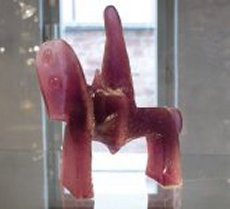Claude Wetzstein: "Parsifal" - German/German

"Parzival" is the famous knight from Wolfram von Eschenbach's 12th century verse novel of the same name. In 1975, the French glass artist Claude Wetzstein created a glass sculpture called "Parsifal". The sculpture was created as a limited series of only 200 pieces at the Daum Frères glassworks in Nancy, France. One copy, number 82, was acquired by the founder of the Glass Museum, Dr. Hans Löber, in 1976 for the newly founded Glass Museum.
The sculpture is made using the "pâte-de-verre" technique. This elaborate technique brings out the sensual expressiveness of glass particularly well. In this melting process, finely ground glass powder is mixed with a binder, kneaded into a mould and then fused into glass in the kiln. Through varying colour intensity and glass thickness, a mystical glow is revealed, which excellently expresses the mysterious figure of "Parsifal".
Wolfram von Eschenbach was in the service of the Count of Wertheim and may have written parts of his "Parzival" at Wertheim Castle. In 2011, the "Parzival" spiral was therefore opened there. With this, the Parzival project group initiated the first step of various Parzival projects that deal with the exciting figure of the "Knight of the Grail". These include, for example, the Parzival banners that hang in the alleys of Wertheim every spring.
Claude Wetzstein: "Parsifal" - English

"Parsifal" is the famous knight from Wolfram von Eschenbach's 12th century verse romance of the same name. In 1975 the French glass artist Claude Wetzstein created a glass sculpture with the name of "Parsifal". It was made as part of a limited series of just 200 pieces in the Daum Frères foundry in Nancy in France. Dr. Hans Löber, the founder of this glass museum, acquired one of these pieces, number 82, for his in 1976 newly opened museum.
The sculpture has been made using "Pâte-de-Verre" technique. This time-consuming and complex technique makes a feature of the sensory expression of glass. This shape-melting process uses finely ground glass powder with a binding agent, which is kneaded into a shape and smelted into glass in a furnace. Different intensities of colour and a thickness of glass bring a mystic glow to light that superbly complement the representation of Parsifal, who is shrouded in mystery.
Wolfram von Eschenbach was in the service of the Counts of Wertheim and could quite possibly have written parts of his "Parsifal," here at Wertheim Castle. For this reason the Parsifal spiral was opened there in 2011 and was the first step taken by the Parsifal project group to research and get to grips with the fascinating figure of the Grail Knight. The Parsifal Banners that hang in Wertheim's streets in Spring are also part of this project.